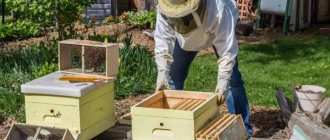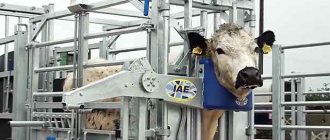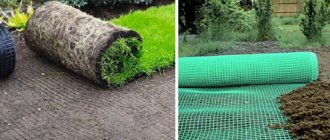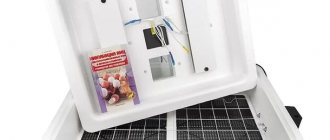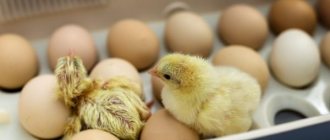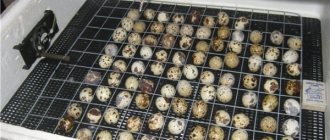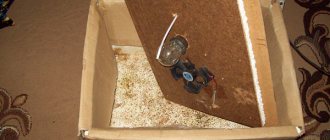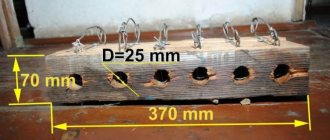Home » Articles about egg incubators » Operation of the Cinderella incubator
The first Cinderella incubator appeared on the market in 1998. Developer and manufacturer – OLSA-Service company (Novosibirsk). To date, 24 series of devices have been developed. The body is made of durable yellow polystyrene foam. The Cinderella incubator is operated in accordance with the instructions supplied with each model.
Cinderella incubators for 28, 45, 70, 98 and 100 chicken eggs
There is probably no villager who would not try to raise poultry on his farm. But if several decades ago such an activity was tedious and not always justified, today, thanks to such an invention as the incubator, the process has become simple and not labor-intensive. Cinderella Incubator is one of the most popular products in the country, which has earned recognition among poultry farmers due to its characteristics.
About the manufacturer
The manufacturer of incubators under the “Cinderella” brand is Novosibirsk, offering the consumer a large selection of devices for “hatching” birds in a low price range.
Today, there are 12 models of Cinderella incubators that can meet the needs of domestic poultry breeders - from summer residents to small farms.
Incubators are made of polystyrene foam, they are equipped with turning mechanisms and operate on electricity, automatically switching to a battery if necessary.
Review of Cinderella incubator models
The main task of any unit is to recreate the most natural masonry conditions in order to reduce the percentage of discards. Just as a hen regularly “turns” the eggs, so in the incubator they turn 180° 10 times during the day. If operating rules are followed, losses are no more than 5%. Let's look at several of the most popular models from this manufacturer.
Cinderella 70
The “Cinderella” incubator for 70 eggs is a compact device, easy to use, intended for poultry farmers with average needs for producing young animals. The unit provides conditions as close as possible to natural ones, which guarantees the production of chicks.
Cinderella incubator for 70 eggs
The model is equipped with automatic turning - 10 times per day, has 2 specialized grates for 70 chicken eggs. Additionally, you can purchase a grill for 40 duck eggs. The design has the function of connecting backup power during a power outage.
The average price for a device in an online store excluding delivery is within 5,000 rubles.
VIDEO: Assembly and startup instructions
Cinderella 45
An economical device for breeding young animals of various types of poultry. One of the cheapest and simplest devices from this manufacturer, spare parts for it will not be a problem if necessary.
Cinderella incubator for 45 eggs with manual turning
The device operates on mains or battery power and is equipped with a patented heating system that allows you to heat eggs even when the electricity is turned off.
Electrical circuit of the incubator
In this model, the tray sealing system is carefully thought out; it practically eliminates leaks and maintains the necessary humidity in the Cinderella incubator.
User manual
VIDEO: Test hatch and incubation results
Cinderella for 28 eggs
Incubator “Cinderella” for 28 eggs, model A-18 – designed for small batches, primarily for breeding chickens. The device automatically turns the eggs and is equipped with an electronic thermometer that shows the user the temperature and humidity level inside.
Incubator Cinderella 28 eggs auto-rotate 220V/12V (power supply included)
The heating system with a water container allows not only to efficiently warm the eggs, but also to maintain the temperature in conditions of a power outage.
The kit includes:
- Incubator body.
- Thermometer.
- Automatic turning device.
- Tube for draining water from the heater.
- Egg rack +2 plastic racks.
- Grill stand.
- Water baths.
- User manual.
It is forbidden to place the device in a draft - window sills, balconies, near open doors. The room should have a stable temperature in the range of 20–25°C.
The average cost is 3,500 rubles.
VIDEO: Review and help for beginning poultry farmers
Cinderella A70
The “Cinderella” incubator for 70 chicken eggs is additionally equipped with a goose grille; if desired, you can add a grille with a fine mesh for quail eggs.
Automatic turning of the future offspring is carried out by a slow horizontal roll under the influence of the movement of the grid. For this purpose, the design includes a gearbox connected to the network.
Incubator Cinderella A-70-12V
The digital thermostat controls the operation of two heating elements located under the cover of the device. Therefore, the user does not have a question about how to reduce the humidity level or temperature. All microclimate data is displayed on a digital display.
The cost of the device will be 4400 rubles.
VIDEO: Overview of work, assembly and installation of A-70-12V
Reviews
To accurately understand all the pros and cons of this model, it is worth considering customer reviews.
| Positive | Negative |
| Light weight | Not very reliable |
| Can be placed in any convenient place | The need for grating control |
| Ease of use | The need to constantly look at the thermometer |
| Battery operation allowed | Mold formation on the walls |
| Low cost | Inaccurate operation of electronics |
| Excellent temperature distribution | |
| Ability to maintain the required level of humidity | |
| Automatic rotation capability | |
| Possibility of heating with hot water | |
| Excellent output up to 98 percent |
All about Cinderella incubators
Little by little, the days when eggs in households were hatched by brood hens are becoming a thing of the past. Nowadays, even in small households, this work is increasingly trusted to incubators. Today, the market offers incubators from different manufacturers and different capacities. But the most popular is the Cinderella incubator for 70 eggs, automatic turning 12 220v - video and instructions for which we offer in this article. This household appliance is one of the best and has deservedly received many positive reviews.
Features of the incubator
The Cinderella incubator, which we recommend for use in households, is inexpensive and pays for itself very quickly. The price depends on the specific model chosen, which differ not only in capacity, but also in the way the eggs are turned. Naturally, the incubator for 98 eggs and with a mechanical turning function is the most expensive, and the cheapest is for 28 eggs with a manual turning.
If we briefly describe the characteristics of this device, the following should be noted:
- If high-quality eggs are selected (the selection takes place on an ovoscope), the hatchability can be 98 percent, this is confirmed by numerous reviews of those who purchased them.
- Depending on the type of incubator, heating containers can have an area of up to 1.5 thousand square centimeters.
- A very economical gear motor can independently turn eggs ten times a day.
- The set includes additional grids and a thermometer.
- Manufacturer's warranty for the incubator is three years.
“Cinderella” is equipped with water-type heaters, which are located on the lid. It is this system, according to numerous reviews, that guarantees uniform heating of eggs. In the automatic turning model, the eggs are turned 180 degrees every 2.5 hours.
Distinctive characteristics
In this device, the heating elements occupy the maximum area. This is done to ensure better heating of the eggs without a fan. The body is made of durable polystyrene foam, which has the best thermodynamic characteristics.
Warming up proceeds as follows. The water is heated using heating elements and heats the metal plate, and from it the heat flows into the incubation chamber. It is this technology that distinguishes the “Cinderella” model from similar incubators from other manufacturers. The heat is distributed more evenly and there are no temperature fluctuations.
Water makes it possible to better maintain the set temperature of the heating elements throughout the entire incubation time. This makes incubation extremely close to natural conditions. It is this feature that, in the case of laying high-quality eggs, guarantees more than 95 percent hatchability, which is confirmed by many reviews.
Incubation process
Cinderella incubators are used for hatching chicks, ducklings, goslings, turkey poults and quails. Basically, laying eggs is carried out in one step. Incubation in Cinderella in terms of timing, humidity and temperature requirements depends on the type and breed of poultry.
Failure to comply with the temperature regime can lead to the death of the entire brood: in hot and dry air the embryo will die from lack of water, and in cold air it will freeze. To ensure that the incubation process is not interrupted during power outages, it is recommended to install an additional battery. And while operating from backup power, the ventilation holes in the device are closed. If there is no electricity for more than 1.5 hours, then the cooled water is drained from the heating elements and boiling water is added. It is recommended to drain the water using a special tube without removing the lid.
Maintaining the required humidity parameters is especially important in the first days, when the embryos develop the main organs.
For all types of poultry, humidity rises to maximum levels in the last incubation days. This makes the shell softer and easier to peck. In humid air, the chicks warm up and dry out faster.
Another important point: frequency of grate rotation and uniform heating. This process is necessary to prevent the embryos from sticking to the inner shell of the shell. During incubation, chicken eggs are checked on an ovoscope on days 7, 12 and 18. The test will identify non-viable embryos. At the last viewing, a brown spot should be clearly visible at the sharp end - a healthy embryo.
Modifications
Choosing an incubator for exactly how many eggs to lay is a purely personal matter and depends on the size of your farm. Perhaps one large one for 98 chicken eggs will suit you, or you may be better off purchasing several smaller ones if you plan to incubate eggs of different types of birds.
Before buying a household incubator, you need to decide in advance not only its size, but also other characteristics:
- In terms of capacity, the manufacturer supplies the market with incubators for 28, 45, 70 and 98 chicken eggs.
- The next important parameter is the method of turning the eggs. Here, at your discretion, you can purchase with a mechanical, automatic and manual turning method.
- Nutrition may also be different. Mostly on sale are models that run only on electricity. But it would be useful to connect a 12 Volt battery. In the event of a power outage, the incubator will operate on battery power for a certain time, perhaps this will be enough until the supply is restored.
If electricity is not supplied for a long time, and the battery powering the incubator has run out of power, you can proceed as follows. Fill ordinary plastic bottles with hot water and cover the body of the device with them. This method will allow you to maintain the desired temperature for a long time.
Instructions for use
Using a household incubator is not that difficult. It is enough to properly prepare for work, select and load eggs and monitor the maintenance of temperature and humidity parameters at the specified levels.
Preparing for work
- Before you start using the incubator, be sure to read the instructions and understand the basic safety rules.
- Place the incubator on a flat horizontal surface and it is advisable for it to remain there for the entire incubation period.
- It is advisable to disinfect all internal surfaces and removable elements with a manganese solution immediately after purchase and before storing.
- We install plastic baths on the bottom, their number depends on the humidity in the room. If it’s very dry, then set it to 5-6; if it’s damp, then you can get by with two.
- We pour water into them. During incubation, you need to ensure that there is always water in these baths; if it evaporates, you need to top it up.
- Place a plastic grill on top.
- If your electricity is often cut off, then do not skimp, but immediately purchase a 12V battery along with the incubator. When connecting, observe polarity. If there is a power failure in the network, the system will automatically switch to backup mode. The charge of the car battery is enough for 24-28 hours of operation of the incubator.
Laying eggs
Of course, the most important stage when incubating eggs is laying them. Before laying, be sure to check all the eggs on an ovoscope; it is better to choose the best 28 out of fifty than to waste time on incubation.
- Before laying, you need to mark all the eggs, no matter whether there are 28 or 98, preferably different on two opposite sides. This is done to make it easier to control the turning process.
- Important! Make sure that all eggs are placed with the same mark facing up. If the incubator is equipped with a turning mechanism, then place the eggs in cells.
- We install the temperature sensor vertically and put on the lid.
- We pour one liter of water into the chambers at a temperature of 85-90 C. If the incubator is not fully loaded, then the temperature of the water poured should be within 70 C.
- We insert the thermometer into the hole between the window and the temperature regulator. Make sure the thermometer probe is just above the eggs. This position cannot be changed throughout the entire incubation period.
- We connect the rotary device to the network.
- According to the instructions, turn on the device after half an hour.
- The temperature should be constantly monitored using a thermometer and be within 38.3-38.7 degrees. If the temperature rises above 39 degrees, the consequences may be irreparable.
- Always make sure that there is water in the trays and containers. Add more as it evaporates.
- During the incubation period, do not open the lid for more than a few minutes. However, periodic ventilation with a short-term decrease in temperature is necessary.
Chicks hatch in 21 days. A couple of days before the end of incubation, you need to turn off the rotary device and also remove the grill. When the chicks are born, you need to wait until they dry out. Then, after about 5-7 minutes, transplant to a warm place where the temperature will be maintained at 37 degrees. After this, you can wash and disinfect all equipment with a solution of potassium permanganate.
Test run
To check functionality:
- baths are filled with warm water;
- the lid is closed;
- 500 ml of hot water is poured into the heaters through the holes, the caps are screwed on;
- The temperature sensor with a thermometer is installed so that the wire is positioned vertically.
The incubator is plugged in and the desired temperature is set using a thermostat (+39°C). Once it is reached, the indicator goes out. After some time, it should turn on again, signaling the operation of the heaters that compensate for cooling. The operation of the device is checked for 2-3 hours.
Temperature accuracy is monitored using an alternative thermometer with a good level of accuracy. After completing the test, turn off the device and drain the water.
The Cinderella incubator will save the bird brood in any conditions!
The electric hen has solved a difficult problem - how to hatch birds if the eggs have been collected and there is no one to hatch them. The Cinderella incubator is an inexpensive thermostat developed at the Olsa-Service enterprise in Novosibirsk. The device takes into account rural reality, and is capable of operating from a 220 V network, with automatic switching to a 12 V battery or receiving heat from poured hot water.
Advantages and disadvantages of application
Advantages:
- Easy to use.
- Takes up little space and is quite compact.
- Ability to operate on 12V battery.
- High percentage hatchability .
- Economical energy consumption.
- Acceptable price .
According to the observations of experienced farmers, the disadvantage is that the process is not fully automated. It is necessary to constantly monitor the temperature and turning of the eggs.
Incubator structure
The incubator consists of the following components:
- Heating elements in the form of metal plates in the amount of 1-3 pcs.;
- water baths - plastic jars, metal bottom with elements for attaching a heater;
- rotating device;
- Digital Thermometer;
- egg racks – 6 pcs.;
- water containers with straws.
The equipment of the household incubator Cinderella is arranged in a polystyrene foam casing with special thermostatic impregnation. The heating unit is installed in the lid and occupies a large area. The dimensions of the device depend on the number of chicken eggs in the stack. Models are designed for 28, 48, 70 and 98 pieces. The set includes grilles for quail and duck eggs.
The hatching of chicks is influenced by the correct humidity regime. It changes as the embryo develops. Lack of water can cause the chick to stick to its shell.
The large area of heating elements in the Cinderella incubator ensures uniform heating of every corner of the brood chamber:
- There is precise temperature control from 31 to 43 0 C, with an error of 0.2 0.
- Roll the embryos 10 times a day 180 degrees.
- Electricity consumption is 75 W. Powered from the mains; when disconnected, a transfer to a car battery is provided. When the battery is discharged, you can maintain the mode for another 10 hours by periodically pouring hot water into the container.
- Measuring and maintaining humidity occurs automatically.
Functionality and adherence to the regime of incubating eggs in natural conditions allows you to obtain a yield of 90-95% even in the absence of experience.
The manufacturer produces Cinderella incubators in several versions:
- no turning mechanism, manual turning every 4 hours;
- mechanical turning of eggs, it is necessary to control the rotation and correct the position of the handle;
- automatic grate rotation.
The more complex and larger the device, the more expensive it is. Small devices are made simply. Automatic revolution has a Cinderella incubator for 70 eggs. Among household models, it can maintain the temperature for almost half a day in hot water.
With all the positive options, the Cinderella incubator needs improvement. The thick foam body requires careful handling - the material is short-lived. A porous surface, heat and humidity are comfortable conditions for the proliferation of microbes. If hygienic conditions are not maintained, mold will appear inside. A cavity infected with microbes will become a source of infection for the brood.
The thermostat for the Cinderella incubator sometimes malfunctions, and the turning of the eggs needs to be monitored. But the low cost of the thermostat and the ability to maintain the mode even during a long power outage compensate for the shortcomings.
Storing eggs before laying
If we think in terms of preparatory manipulations, it becomes quite obvious that the temperature of hatching chickens in the incubator is an important element, which we will discuss in more detail in the article.
But it also wouldn’t hurt to devote a little time to analyzing such a moment as storage. The material that is selected for the future brood is very delicate in all respects, and therefore the conservation regulations require an equally serious approach to observing thermal boundaries.
It is not recommended to allow the temperature to drop below +10 C°, and +18 C° is considered the most optimal. The exception is the stage of immediate readiness for placement in trays and start of incubation.
